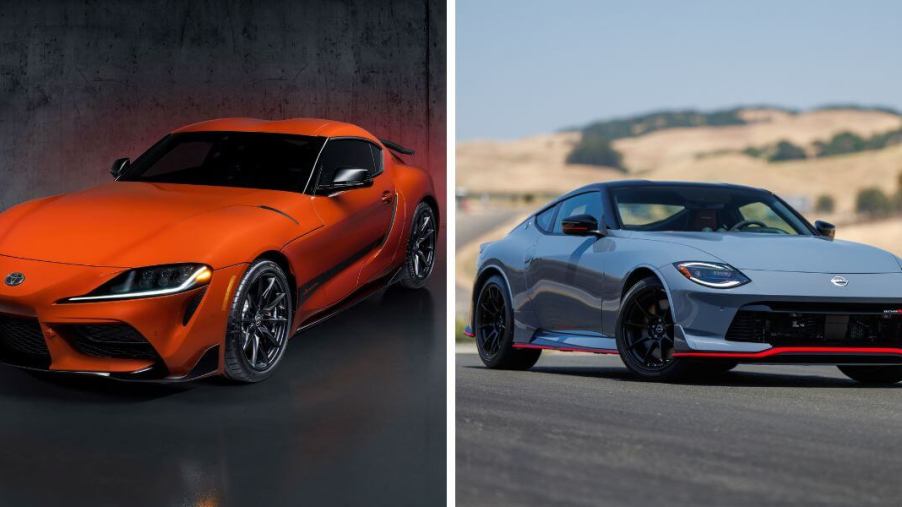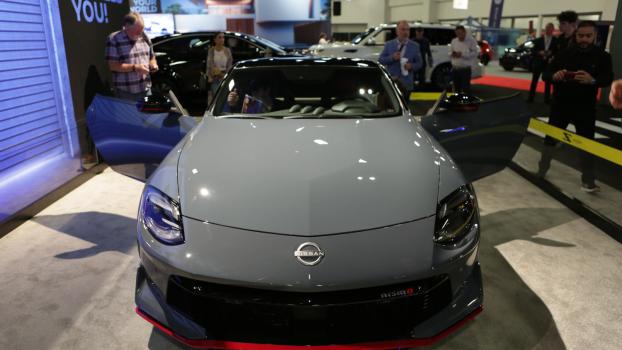
The 2024 Nissan Z Is Only Better Than the 2024 Toyota GR Supra on Paper
The Nissan Z has ushered in a new era for the mid-tier sports car and continued its long and storied history in the performance market. The latest Z is now a prime competitor for the revitalized Toyota Supra, now the GR Supra, another relatively affordable sports car with a historied nameplate. Looking purely at the specs, the Nissan Z is victorious in many regards. However, beyond sheer numbers, the GR Supra has plenty of its own advantages.
The Nissan Z vs. GR Supra — Tale of the tape
The new Nissan Z, introduced for the 2023 model year, is motivated by a 3.0-liter twin-turbo V6 dishing out 400 horsepower and 350 lb-ft of torque to the rear wheels. In a win for “stick” enthusiasts, the Z comes standard with a six-speed manual transmission, but buyers can opt for a nine-speed automatic with rev-matching and paddle shifters if they so choose. The 2024 Z carries a starting price of $40,990 for the base version with either transmission.
The base 2024 Toyota GR Supra commands a $45,540 MSRP for the base “2.0” version. The 2.0 GR Supra is powered by a turbocharged inline-four developing 255 hp and 295 lb-ft of torque paired exclusively to an eight-speed automatic.
Those willing to pay more, and get more performance, can opt for the higher-performance versions of each model.
The new 2024 Nissan Z Nismo ups the ante to 420 hp and 384 lb-ft of torque with a track-focused drive mode, upgraded tires, larger brakes, a Nismo-tuned nine-speed automatic, some bodywork upgrades that pay additional homage to the Z’s past, and additional performance kit.
The Supra 3.0, as the name implies, is powered by a 3.0-liter turbo inline-six cranking out 382 hp and 368 lb-ft of torque. It can also be had with a six-speed manual with automatic rev-matching for no additional cost.
The Nissan Z’s many advantages
On paper, the Z seems to win the fight with relative ease.
The Z’s base 400 horsepower is more than you get from any version of the Supra. To boot, the Z can be had with a manual in its lowest-cost trim, while you need to spend about $9,000 over the base GR Supra for the 382-hp 3.0 model to get near the same level of power of the Z and to make available the manual transmission option.
That price jump is significant as the Z starts about $4,500 cheaper out of the gate between the two base models, and the Nissan holds the edge throughout the range. The mid-level Z Performance trim rings in just under $51,000, several thousand dollars cheaper than the 3.0 GR Supra.
You’d also be hard-pressed to find someone who didn’t appreciate the Z’s retro-inspired design over the GR Supra’s questionable styling.
So, the Z costs less, offers more power, is better looking, and doesn’t require additional dollars to be spent for drivers to do the shifting themselves. On the spec sheet, the GR Supra only has two notable advantages — it’s more economical with its fuel consumption, and it provides 10 cubic feet of cargo space to the Z’s 7 cubic feet.
Of course, the spec sheet never fully tells the story.
The GR Supra wins where it matters — on the road
When comparing sports cars, it’s vital to look beyond the raw numbers, and the GR Supra vs. Z battle underscores that importance (this author has tested both models and can attest to this first-hand).
Yes, the GR Supra may cost more, but it is far more refined when the going goes twisty. The Gazoo Racing product has far better road-handling capabilities overall. One reason is that the Z’s Bridgestone Potenza rubber holds it back. The Supra carves up corners with relative ease, while the Z can feel unsettled over mid-corner road imperfections and lacks the overall grip the Supra delivers.
Both have impressive braking performance in their mid-level trims, but the Z can’t compete with the Supra’s stopping ability. Under full-stop braking, the Supra’s brakes perform as if the sports car was driven onto wet cement. The Supra 3.0 may be at a horsepower disadvantage, but its acceleration still outpaces the Z in real-world testing.
The Supra’s cabin is also far more refined. It’s underpinned by the BMW Z4, after all, and its cockpit feels downright luxurious compared to the Z’s, which is awash in hard plastics and cheaper-feeling materials. The Nissan also trails the GR Supra on the daily drive — its cabin is filled with the rather dull sound of its turbo V6, and road/wind noise is pervasive.
Ultimately, the GR Supra and Nissan Z are attractive options for a mid-tier performance car. Though the Z may have many advantages on paper, the GR Supra makes up for its spec-sheet deficiencies with its real-world performance and driving experience.




